|
Godzilla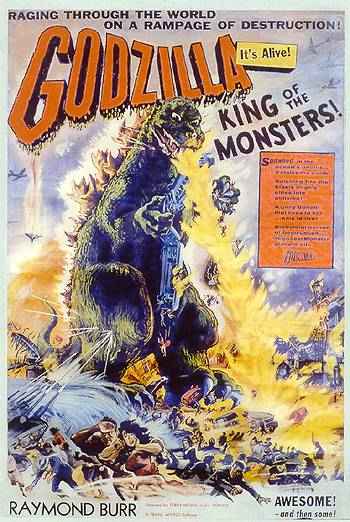 There's a poignantly sad message behind Godzilla, the giant, fire-breathing, guy-in-a-rubber-suit lizard which has replaced Tao and the samurai as the overwhelming spiritual metaphor for the national identity of Japan. It's as if Jerry Springer came over to your house on Thanksgiving Day a mortifying exposure of every fucked-up, shame-tainted neurosis, presented to the world as entertainment.
There's a poignantly sad message behind Godzilla, the giant, fire-breathing, guy-in-a-rubber-suit lizard which has replaced Tao and the samurai as the overwhelming spiritual metaphor for the national identity of Japan. It's as if Jerry Springer came over to your house on Thanksgiving Day a mortifying exposure of every fucked-up, shame-tainted neurosis, presented to the world as entertainment. We're not laughing with the Japanese. We're not even laughing at them. We're just uncomfortably averting our eyes from their naked national psyche, waiting for the painful honesty and inferiority complex to play itself out before the fun city-smashing rampage can begin. Now, granted, being the only nation in history to fall victim to nuclear war will do strange things to a country. It just highlights the strangeness of modern life that the most lasting and easily the most visible consequence of history's single most significant event should be Godzilla. Godzilla first burst onto the scene in 1954, in "Godzilla: King of the Monsters." Much like the original "Frankenstein" or "Dracula," the first Godzilla movie was a serious and reasonably scary flick, filmed in black and white on a miniscule budget. The monster himself was pretty cheesy-looking, and clearly a guy in a rubber suit, but dammit, it was good! The movie also carried a grim and pretty overt message about the horrors of nuclear war, since Godzilla was a mutant beast created by radioactive contamination. Coming from the only victims of the Atomic Bomb ever, the message was reasonably compelling. The movie was a smash hit, assisted in part by the addition of footage featuring Raymond Burr for an American release. It immediately spawned a sequel, "Godzilla Raids Again," which added a second monster for Godzilla to fight, formally spawning the genre of "kaiju," a Japanese word which translates as "giant monster" (unsurprisingly). That was when things started getting weird.
After the success of Godzilla, several other giant monsters debuted in movies of their own, including Rodan, an oversized pterodactyl, and Mothra, a giant... well, Mothra is a moth in spirit, if not by virtue of any meaningful anatomical resemblance. Mothra also has these two tiny women who sing to it and... Well, we're getting distracted here, but take my word for it, Mothra is just bizarre. Virtually all of these kaiju would eventually duke it out with Godzilla, sometimes several at once, with the notable exception of Gamera, a giant flying turtle made by a competing film company, with its own cult following. ("Godzilla vs. Gamera" is the ultimate dream match for fans of the genre, and sooner or later, they'll get around to doing it.) In format and execution, Godzilla movies are a lot like Professional Wrestling. Monsters run up and attack each other for no apparent reason, monsters who were enemies in one movie are friends in the next, "heel" monsters regularly turn "babyface" and vice versa, and the concept of "continuity" is for loser Star Trek fans. Not only do Godzilla movies routinely ignore preceding Godzilla movies, but they will happily ignore the storyline of the immediately preceding movie in the series, or even occasionally ignore the first half of the current movie in the second half. Toho, the company which owns Godzilla, has pressed the "reset button" on the franchise at least three times, which means that there are at least four totally contradictory movies which purport to be direct sequels to Godzilla 1954, which has to be some kind of record. U.S. filmmakers decided to take a crack at Godzilla in 1998, but the result was a barely watchable bit of tripe that destroyed the charm of the original and lacked the key component that lends Godzilla its weird charm, namely the Japanese national dysfunction. Having been the victims of not one but two nuclear blasts, combined with the complete disarmament of a nation whose lore reveres the warrior figure, has left the Japanese psyche seriously bent, as the country's fucked up relationship with Godzilla amply demonstrates.
Through the end of the 1950s and the early 1960s, this ambiguity ran thick through the Godzilla films, most typically playing out with Godzilla making an appearance which scares the shit out of everyone, but then an even worse monster shows up and Godzilla fights that monster, before disappearing into the sea. As the '60s wore on, and the movies began to multiply, Godzilla stopped being so scary and started to be lovable. By the time "Godzilla vs. Monster Zero" (one of the weirdest head trips ever committed to film) debuted, Godzilla was firmly viewed as the "protector of Japan." Which is why the aliens from Planet X kidnap him and subject him to evil mind control. With the addition of Minya, aka "baby Godzilla," the whole franchise pretty much took a steep dive into the maudlin, and Godzilla was firmly on the side of the angels, fighting off evil threats like Gigan (a cyborg monster sent by evil cockroaches to conquer Earth), Ghidorah (a three-headed dragon, and one of the coolest non-Godzilla kaiju) and Hedorah, the Smog Monster. Minya himself was a precursor to Pokemon, just the cutest durn thing you ever saw and he blows little smoke rings instead of breathing fire! Awwwwwwww... The recurring plots of these movies swing between a weirdly grandiose vision of Japan's status and a strange masochistic desire to absorb punishment. After all, every single alien invader or evil monster on the planet seemed to be unwaveringly drawn to Japan, clearly the most important nation in the world. But at the same time, these monster battles were unbelievable epics of city carnage, leaving Japanese cities (and often the capital, Tokyo) in flames and ruins over and over again. The movies also featured the Japanese military in all its fearsome might, which was a pretty good sign of the dysfunction, since there had been no Japanese military to speak of since World War II.
After a short hiatus, Toho decided that the best thing to do was completely reinvent the franchise. So they made "Godzilla 1984," which was a sequel to the 1954 original and pointedly ignored everything that had been committed to film in between from Gigantis to Gigan to Megalon to Hedorah to Rodan to Planet X to... Well, you get the drift. "Godzilla 1984" hearkened back to the fucked-up worldview of the original, namely that Japan was being punished for its evil ways and that the whole atom bomb thing was really, really bad. Raymond Burr even reprised his role from the original movie as "That White Guy." The new film was a smash hit, and the sequel machine shifted into high gear. However, things had changed for Japan. In the 1950s and '60s, Japan was still suffering through its post-war comeuppance. In the 1980s and 1990s, Japan had been transformed into a technological and economic powerhouse. The new series of Godzilla movies, released through the 1990s, had to come up with a whole new series of rationales about why Japan deserved to be punished. In the most overtly political film of the new series, "Godzilla vs. King Gidorah," White Guys from the future come back through time to "help" Japan by getting rid of Godzilla. However, the White Guys have a hidden agenda. You see, in the future, Japan's economic might has grown so great that all the other nations of the world pale in comparison, and Japan dominates the Earth. The disgruntled White Guys get rid of Godzilla and replace him with King Gidorah (the three-headed dragon) whose purpose is to destroy Japan so that White Guys can take their place as the rightful owners of everything.
The time-traveling White Guys fail to stop Godzilla from being created, but they do manage to cause him to be reborn as an even bigger guy in a rubber suit, and with a nastier disposition. This is explicitly laid out in the movie as "Godzilla is no longer a friend to Japan." The White Guys at some point explain their reasoning in having Japan destroyed, which is that the Japanese have become arrogant and vain, and they aren't careful enough with their nuclear waste. Thus, they deserve everything they theoretically have coming to them. The movie ends with the one Japanese woman from the future saving the country from Godzilla using a Borgified King Gidorah. The moral of the story is decidedly unclear. Despite all this, Godzilla continued to have an ambiguous relationship with the Japanese through the remainder of the 1990s, generally trashing the place but occasionally defending it from something worse than himself, until the big guy finally bit the bullet in "Godzilla vs. Destroyah," in which Godzilla is about to have a meltdown in his radioactive heart and destroy the whole world, but instead manages to save Japan from an even worse monster before heroically going down with the ship (along with the recently reconstituted Minya).
So they hit the reset button one more time for "Godzilla vs. Mothra vs. Ghidorah: Giant Monsters All Out Attack." This time, they explained that Godzilla was actually the demonic incarnation of all the dead souls of the Japanese soldiers killed in World War II, which is why he can't be killed. Interestingly, with all this going on, not one single Godzilla movie has ever suggested that the big guy is avenging the hundreds of thousands of civilians killed by the U.S. atomic bombing of the country. Frankly, this oversight is downright bizarre. If the Japanese ever had a legit beef, it would have to be the bombing of Hiroshima and Nagasaki. Instead of confronting the issue head on and letting the healing begin, this mass entertainment vehicle has taken on a life of its own, with the major purpose of intentionally asking and unintentionally answering the question: "What's wrong with Japanese people?" A massive worldwide relief effort could perhaps send teams of psychologists and doctors and healers of every kind to Japan, to help the population come to terms with the wrenching pain of their history and allow them to finally, once and for all, rise from the atomic ashes of World War II. But then, we probably wouldn't have any more Godzilla movies if that happened. It's unfortunate that sometimes you have to suffer for the sake of your art, but if you're really lucky, you can get someone else to suffer for the sake of your entertainment.
|
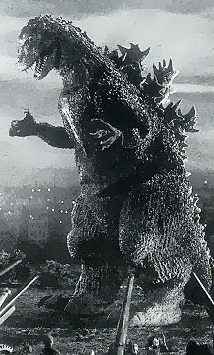 Godzilla has spawned nearly 30 official movies, as well as a host of spinoffs. The films range from spectacles to farces to just plain insane. The one thing most of these films have in common is that they really, really make you wonder about what goes on in the Japanese mind.
Godzilla has spawned nearly 30 official movies, as well as a host of spinoffs. The films range from spectacles to farces to just plain insane. The one thing most of these films have in common is that they really, really make you wonder about what goes on in the Japanese mind. 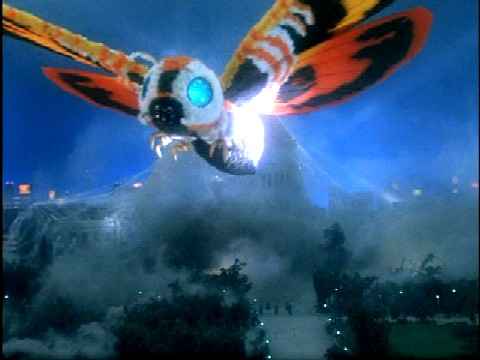 In his debut, Godzilla shows up, trashes the country and generally wreaks a lot of misery. But as the sequels kept on coming, Godzilla changed from "enemy of the state" to "abusive boyfriend." Sure, he flies into a rage and trashes the place, but dammit, we love him anyway!
In his debut, Godzilla shows up, trashes the country and generally wreaks a lot of misery. But as the sequels kept on coming, Godzilla changed from "enemy of the state" to "abusive boyfriend." Sure, he flies into a rage and trashes the place, but dammit, we love him anyway! 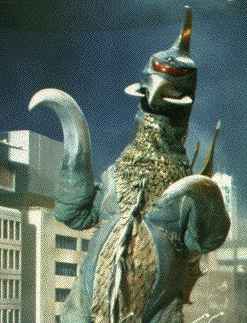 The franchise began to lose direction with a series of films that downplayed Japan's role as center for Monster Attacks, focusing instead on Monster Island, or other rural locations that a) removed the major attraction of the films, namely the sight of cities being demolished, and b) removed the "punish the people of Japan" theme, which was the heart of the whole zeitgeist. (The reasons for punishing the people of Japan varied, but it usually had something to do with pollution or their despicable tendency to be the victims of atomic weapons.) The popularity of the films began to wane.
The franchise began to lose direction with a series of films that downplayed Japan's role as center for Monster Attacks, focusing instead on Monster Island, or other rural locations that a) removed the major attraction of the films, namely the sight of cities being demolished, and b) removed the "punish the people of Japan" theme, which was the heart of the whole zeitgeist. (The reasons for punishing the people of Japan varied, but it usually had something to do with pollution or their despicable tendency to be the victims of atomic weapons.) The popularity of the films began to wane. 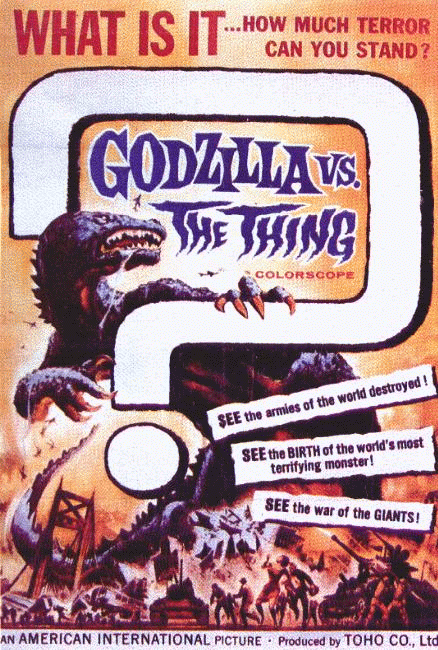 Oh, but wait, there's more! We also learn the secret origin of Godzilla, who was once a surviving dinosaur on a Pacific Island, where he saved a garrison of Japanese soldiers from bloodthirsty American troops during World War II, then was subsequently exposed to the radiation which transformed him into Godzilla proper. So Godzilla is not only pro-Japan, he's also anti-American.
Oh, but wait, there's more! We also learn the secret origin of Godzilla, who was once a surviving dinosaur on a Pacific Island, where he saved a garrison of Japanese soldiers from bloodthirsty American troops during World War II, then was subsequently exposed to the radiation which transformed him into Godzilla proper. So Godzilla is not only pro-Japan, he's also anti-American.  You'd think we would be about done by now, but it just keeps going. After the American Godzilla failed to garner critical plaudits, Toho went back to the well for "Godzilla 2000," which again ignored all the previous movies (except the first) and in which the big green stomping machine defends Japan against a worse menace but subsequently viciously trashes the country on his own. A few more sequels entertained but didn't reignite the phenomenon, perhaps because they never articulated what Japan was being punished for this time around.
You'd think we would be about done by now, but it just keeps going. After the American Godzilla failed to garner critical plaudits, Toho went back to the well for "Godzilla 2000," which again ignored all the previous movies (except the first) and in which the big green stomping machine defends Japan against a worse menace but subsequently viciously trashes the country on his own. A few more sequels entertained but didn't reignite the phenomenon, perhaps because they never articulated what Japan was being punished for this time around.